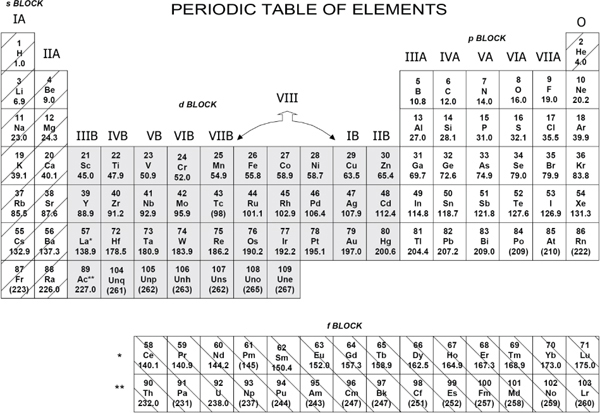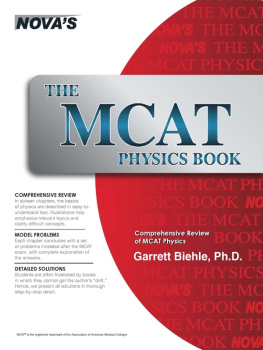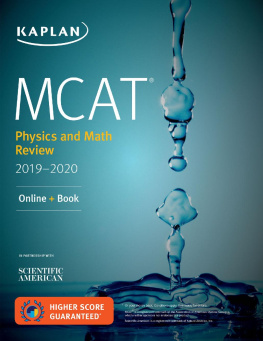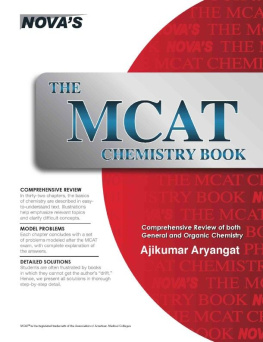
 Additional educational titles from Nova Press (available at novapress.net):
Additional educational titles from Nova Press (available at novapress.net):  GRE Prep Course (624 pages, includes software) GRE Math Prep Course (528 pages)
GRE Prep Course (624 pages, includes software) GRE Math Prep Course (528 pages)  GMAT Prep Course (624 pages, includes software) GMAT Math Prep Course (528 pages) GMAT Data Sufficiency Prep Course (422 pages)
GMAT Prep Course (624 pages, includes software) GMAT Math Prep Course (528 pages) GMAT Data Sufficiency Prep Course (422 pages)  Master The LSAT (608 pages, includes software and 4 official LSAT exams)
Master The LSAT (608 pages, includes software and 4 official LSAT exams)  The MCAT Physics Book (444 pages) The MCAT Biology Book (416 pages) The MCAT Chemistry Book (428 pages)
The MCAT Physics Book (444 pages) The MCAT Biology Book (416 pages) The MCAT Chemistry Book (428 pages)  SAT Prep Course (640 pages, includes software) SAT Math Prep Course (404 pages)
SAT Prep Course (640 pages, includes software) SAT Math Prep Course (404 pages)  ACT Math Prep Course (402 pages) ACT Verbal Prep Course (248 pages)
ACT Math Prep Course (402 pages) ACT Verbal Prep Course (248 pages)  Scoring Strategies for the TOEFL iBT: (800 pages, includes audio CD) Speaking and Writing Strategies for the TOEFL iBT: (394 pages, includes audio CD) 500 Words, Phrases, and Idioms for the TOEFL iBT: (238 pages, includes audio CD) Americanize Your Language and Emotionalize Your Speech! (210 pages)
Scoring Strategies for the TOEFL iBT: (800 pages, includes audio CD) Speaking and Writing Strategies for the TOEFL iBT: (394 pages, includes audio CD) 500 Words, Phrases, and Idioms for the TOEFL iBT: (238 pages, includes audio CD) Americanize Your Language and Emotionalize Your Speech! (210 pages)  Law School Basics: A Preview of Law School and Legal Reasoning (224 pages)
Law School Basics: A Preview of Law School and Legal Reasoning (224 pages)  Vocabulary 4000: The 4000 Words Essential for an Educated Vocabulary (160 pages) Copyright 2012 by Nova Press Previous editions: 2010, 2005, 2000, 1997 All rights reserved. Duplication, distribution, or database storage of any part of this work is prohibited without prior written approval from the publisher. ISBN-10: 1889057339 ISBN-13: 9781889057330 MCAT is a service mark of the Association of American Medical Colleges.
Vocabulary 4000: The 4000 Words Essential for an Educated Vocabulary (160 pages) Copyright 2012 by Nova Press Previous editions: 2010, 2005, 2000, 1997 All rights reserved. Duplication, distribution, or database storage of any part of this work is prohibited without prior written approval from the publisher. ISBN-10: 1889057339 ISBN-13: 9781889057330 MCAT is a service mark of the Association of American Medical Colleges.  9058 Lloyd Place West Hollywood, CA 90069 Phone: 1-800-949-6175 E-mail: Website: www.novapress.net
9058 Lloyd Place West Hollywood, CA 90069 Phone: 1-800-949-6175 E-mail: Website: www.novapress.net
Preface
The physics portion of the Medical College Aptitude Test (MCAT) contains questions to test your knowledge of basic physics and your ability to apply that knowledge to unfamiliar situations. The goal of this book is to review basic physics with an emphasis on the principles and ideas, and to help you learn to approach new situations and think about them with a physics mindset. This book is not primarily concerned with test-taking techniques.
It is designed to help you develop an intuitive understanding of physics, so that you will understand the MCAT questions and how to answer them. Each chapter contains a discussion of a major physics topic, followed by problems to help you apply the concepts. Finally, there are MCAT-style passages and questions to help you get used to the MCAT format. All the problems have complete solutions in the back of the book, some with tips to help you approach problems and to solve them faster. If you work through this book, taking notes with pencil and paper by your side, and solving the problems, you will improve your understanding of physics.
ACKNOWLEDGMENTS
The author wishes to thank James Aldridge for his comments on the manuscript.
ACKNOWLEDGMENTS
The author wishes to thank James Aldridge for his comments on the manuscript.
The author wishes to thank Michelle Haller for the many hours she spent editing the books prose. The author especially appreciates Andrew and Judy Cordell for their critical reading of the book, alerting the author to subtleties in the science, helping the author approach difficult topics, and pointing out unnecessary detail.
Contents

Chapter 1
Introduction
A. Philosophy of the Book
This book is about the concepts of physics, with the goal to prepare you, the reader, to pass the physics part of the MCAT. The physics and chemistry portions of the MCAT consist mainly of a series of passages, each with several questions or problems. Often the passages involve unfamiliar situations and, rather than numbers, explanations, relationships among various quantities, and extrapolations to new situations.
Physics and chemistry problems are sometimes mixed, and there is no ordering from easy to difficult. When pre-med students find out about the exam, they are often fearful. How do you prepare for such a thing? The short answer is: by thinking and doing physics. This book actually has several goals. One is to give you a working knowledge of the basic concepts of physics. Although you will not need a battery of specialized equations, you should remember enough equations to understand the ideas.
The text portion of this book covers all the topics listed in the MCAT study guide, but it omits details included in many freshman physics texts. Instead, it concentrates on the underlying ideas. Another goal is to teach you how to solve problems in science. But you cannot learn to solve problems by simply reading about physics. The way to learn is to solve problems. Then you can solve future problems, for example, on the MCAT, by thinking in the same way as when you solved problems before.
For this reason each chapter contains problems in the text with full explanations, as well as problems for you to solve at the end. The solutions at the back of the book tell you how to think about the problems, which clues to look for, and what methods to apply. The goal is for you to learn how to approach new problems. In each chapter the initial problems are simple, in order to help you to practice your understanding of the concepts in that chapter. These problems may be easy questions or single problems involving some calculations. Although they are not a close approximation of MCAT questions, you will have difficulty on the exam unless you learn to do these first.
Gradually, the problems in a chapter become more difficult, and at the end of every chapter there are MCAT-style passages. In all, there are 51 passages in this book.
B. Reading this Book
Reading a book about physics is completely different from reading a novel. First of all, you must be at a desk and have paper and a pen or pencil. You should write down every equation, making sure you understand all the symbols.
You should reproduce every diagram, working to understand, for example, why certain forces are there and no others, and so on. You may even try working the examples before reading the solutions and work the solutions out along side the text. It is especially important that you keep an open mind and visualize what you read. In biology one can actually see organelles with an electron microscope. Understanding the operation of enzymes requires a little bit more imagination. In physics, you must rely on imagination even more, but it is not too different from imagining the working of enzymes.
Next page






 Additional educational titles from Nova Press (available at novapress.net):
Additional educational titles from Nova Press (available at novapress.net):  GRE Prep Course (624 pages, includes software) GRE Math Prep Course (528 pages)
GRE Prep Course (624 pages, includes software) GRE Math Prep Course (528 pages)  9058 Lloyd Place West Hollywood, CA 90069 Phone: 1-800-949-6175 E-mail: Website: www.novapress.net
9058 Lloyd Place West Hollywood, CA 90069 Phone: 1-800-949-6175 E-mail: Website: www.novapress.net